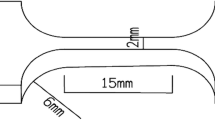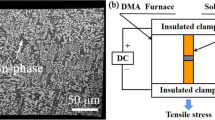Abstract
The creep behaviour of Sn–3.0Ag–0.5Cu lead-free solder specimens with a diameter of 1.0 mm is investigated subjected to tensile forces from 10 to 25 N under electric currents ranging from 0 to 20 A. Due to the Joule heating effect, the solder temperature induced by electric current is measured to quantify the deterioration of tensile behaviour. Based on the observed steady-state creep deformation, the creep strain rate varies linearly with the tensile stress in the natural logarithmic coordinate with a stress threshold for the electric current between 0 and 10 A, and the natural logarithm of creep rate has a linear relationship with the square of current density. By revealing the dislocation climbing as the dominate creep mechanism under the coupled mechanical–electric–thermal loading, a modified Norton’s model is proposed which shows exponential dependence on the square of current density and the natural logarithm of tensile stress with the stress exponent enriched as a quadratic function of current density.








Similar content being viewed by others
References
Osterman M (2006) Being “RoHS Exempt” in a Pb-free world. The Capital SMTA chapter Pb-free tutorial program. Electronic Products and Systems Center, University of Maryland, College Park
Long X, Wang SB, He X, Yao Y (2017) Annealing optimization for tin–lead eutectic solder by constitutive experiment and simulation. J Mater Res 32:3089–3099
Long X, He X, Yao Y (2017) An improved unified creep-plasticity model for SnAgCu solder under a wide range of strain rates. J Mater Sci 52:6120–6137. https://doi.org/10.1007/s10853-017-0851-x
Salandro WA, Jones JJ, McNeal TA, Roth JT, Hong ST, Smith MT (2010) Formability of Al 5xxx sheet metals using pulsed current for various heat treatments. J Manuf Sci Eng Trans ASME 132:051016
Pan L, He W, Gu B (2016) Effects of electric current pulses on mechanical properties and microstructures of as-quenched medium carbon steel. Mater Sci Eng A 662:404–411
Klypin AA (1973) Creep of metals under the influence of electric current. Strength Mater 5:1064–1068
Ren F, Nah JW, Tu KN, Xiong B, Xu L, Pang JHL (2006) Electromigration induced ductile-to-brittle transition in lead-free solder joints. Appl Phys Lett 89:1672–1679
Ha SS, Sung JY, Yoon JW, Jung SB (2011) Influence of current density on mechanical reliability of Sn–3.5Ag BGA solder joint. Microelectron Eng 88:709–714
Xuan FZ, Shao SS, Chen QQ (2011) Synthesis creep behavior of Sn63Pb37 under the applied stress and electric current. Microelectron Reliab 51:2336–2340
Chen R, Yang F (2008) Impression creep of a Sn60Pb40 alloy: the effect of electric current. J Phys D Appl Phys 41:1525–1528
Chen R, Yang F (2008) Electrocontact heating in a Sn60–Pb40 solder alloy. J Phys D Appl Phys 41:065404
Zhao G, Yang F (2014) Effect of DC current on tensile creep of pure tin. Mater Sci Eng A 591:97–104
Su F, Mao R, Wang X, Wang G, Pan H (2011) Creep behaviour of Sn–3.8Ag–0.7Cu under the effect of electromigration: experiments and modelling. Microelectron Reliab 51:1020–1024
Li WY, Jin H, Yue W, Tan MY, Zhang XP (2016) Creep behavior of micro-scale Cu/Sn–3.0Ag–0.5Cu/Cu joints under electro–thermo–mechanical coupled loads. J Mater Sci Mater Electron 27:1–12
Bai N, Chen X (2009) A new unified constitutive model with short- and long-range back stress for lead-free solders of Sn–3Ag–0.5Cu and Sn–0.7Cu. Int J Plast 25:2181–2203
Chen G, Liu L, Du J, Silberschmidt VV, Chan YC, Liu C, Wu F (2016) Thermo-migration behavior of SAC305 lead-free solder reinforced with fullerene nanoparticles. J Mater Sci 51:1–15. https://doi.org/10.1007/s10853-016-0234-8
Schreck T, Schnorpfeil A, Kaloudis M (2013) Analysing the growth of intermetallic compounds in lead-free solder joints by differential scanning calorimetry measurements. J Mater Sci 48:2479–2484. https://doi.org/10.1007/s10853-012-7035-5
Xia Y, Xie X, Xie X, Lu C (2006) Intermetallic compounds evolution between lead-free solder and cu-based lead frame alloys during isothermal aging. J Mater Sci 41:2359–2364. https://doi.org/10.1007/s10853-006-4501-y
Kim MJ, Lee K, Oh KH, Choi IS, Yu HH, Hong ST, Han HN (2014) Electric current-induced annealing during uniaxial tension of aluminum alloy. Scr Mater 75:58–61
Kim MJ, Lee MG, Hariharan K, Hong ST, Choi IS, Kim D, Oh KH, Han HN (2016) Electric current–assisted deformation behavior of Al–Mg–Si alloy under uniaxial tension. Int J Plast 94:148–170
Hariharan K, Kim MJ, Hong ST, Kim D, Song JH, Lee MG, Han HN (2017) Electroplastic behaviour in an aluminium alloy and dislocation density based modelling. Mater Des 124:131–142
Norton F, Bailey R (1954) Creep of steel. Trans ASM 52:114
Orr RL, Sherby OD, Dorn JE (1953) Corrections of rupture data for metals at elevated temperature. Trans ASM 46:113–156
Ochoa F, Deng X, Chawla N (2004) Effects of cooling rate on creep behavior of a Sn–3.5Ag alloy. J Electron Mater 33:1596–1607
Ma H (2009) Constitutive models of creep for lead-free solders. J Mater Sci 44:3841–3851. https://doi.org/10.1007/s10853-009-3521-9
Mathew MD, Yang H, Movva S, Murty KL (2005) Creep deformation characteristics of tin and tin-based electronic solder alloys. Metall Mater Trans A 36:99–105
Wiese S, Wolter KJ (2004) Microstructure and creep behaviour of eutectic SnAg and SnAgCu solders. Microelectron Reliab 44:1923–1931
Yang W (2001) Mechatronic reliability. Tsinghua University Press, Beijing
Ma H, Suhling JC (2009) A review of mechanical properties of lead-free solders for electronic packaging. J Mater Sci 44:1141–1158. https://doi.org/10.1007/s10853-008-3125-9
Long X, Feng YH, Yao Y (2017) Cooling and annealing effect on indentation response of lead-free solder. Int J Appl Mech 9:1750057
Long X, Wang SB, Feng YH, Yao Y, Keer LM (2017) Annealing effect on residual stress of Sn–3.0Ag–0.5Cu solder measured by nanoindentation and constitutive experiments. Mater Sci Eng A 696:90–95
Acknowledgements
This work was supported by the National Natural Science Foundation of China (Nos. 51508464 and 11572249), the Natural Science Foundation of Shaanxi Province (No. 2017JM1013), the Fundamental Research Funds for the Central Universities (No. 3102016ZY017) and the Astronautics Supporting Technology Foundation of China (No. 2017-HT-XG).
Author information
Authors and Affiliations
Corresponding author
Rights and permissions
About this article
Cite this article
Long, X., Tang, W., Xu, M. et al. Electric current-assisted creep behaviour of Sn–3.0Ag–0.5Cu solder. J Mater Sci 53, 6219–6229 (2018). https://doi.org/10.1007/s10853-017-1967-8
Received:
Accepted:
Published:
Issue Date:
DOI: https://doi.org/10.1007/s10853-017-1967-8




